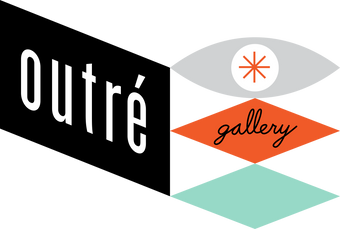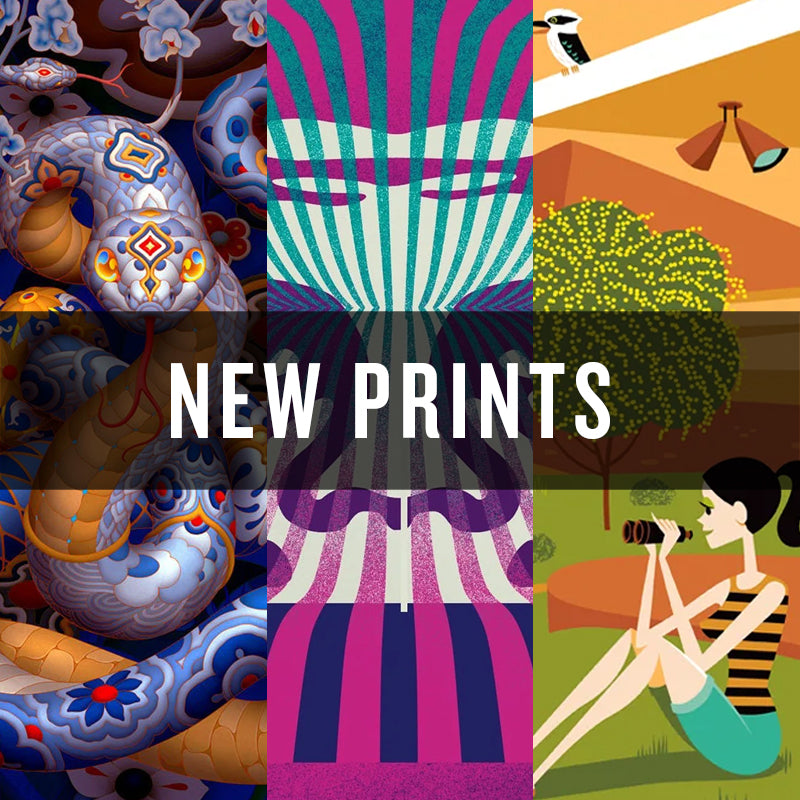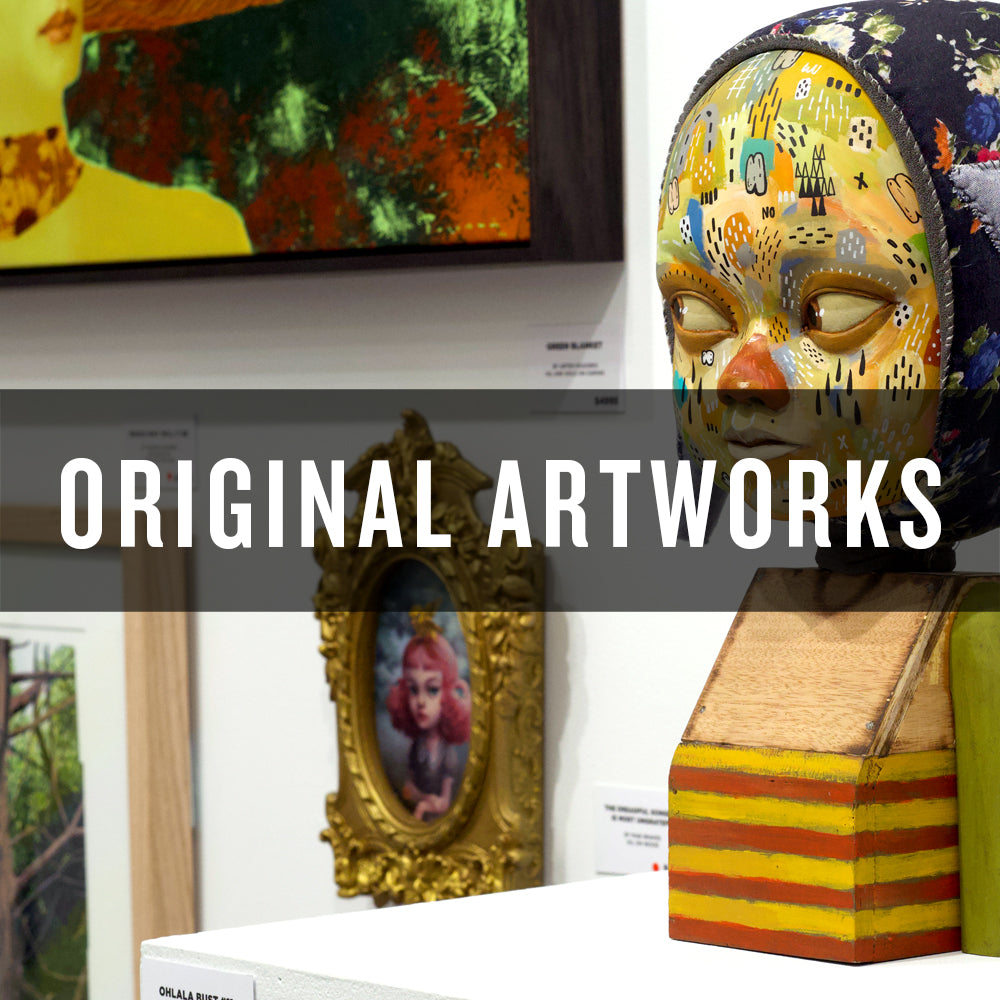This week we are honoured to share with you an interview with Martin McIntosh, Director of Outré Gallery. As a young man with a big vision, Martin decided to open a gallery with no prior experience. Motivated by the sheer passion for art and celebrating the skills of artists, Martin created and nurtured the gallery over two decades into what it is today.
We recently sat down with Martin and spoke to him about his time as Director, what his early years were like, his inspirations and mentors, and how the gallery has transformed over time.
Set the scene for us – you are a young man in Melbourne and have the dream to open an art gallery. Talk us through your vision.
I was driven by enthusiasm and naivety! I did have a vision of essentially creating an accessible gallery that catered to all of the areas that interested me. I was inspired by what was considered “low art” at the time – comic books, pulp fiction cover illustration, Japanese animation and trash culture. Things that weren’t really given much thought at the time, but have since become much more legitimate.

Were you at art school or an artist yourself at the time? Where did your immense drive come from to open an eccentric gallery filled with pop-art artists from such niche subcultures?
I was studying a Bachelor of Arts degree and dabbling in many subjects, not really sure of what I wanted to do with my life. I’d come from a family with a small business. My dad was a magician (and amateur artist) who had started his own shop when he was young, selling magic tricks, jokes and novelties. So without thinking about it too deeply, I just followed the maxim of “follow your passions”.
I was inspired by the art I saw at the time. There was Robert Williams, who was creating these wonderfully detailed narrative works drawings on everything I found exciting: EC comic books, circus sideshow banners, tattoo art and vintage advertising graphics! These were paintings one would just stare at for hours and draw inspiration from. It was genuinely exciting! I wanted to recreate this experience for others.

What was the Melbourne art-scene like in the 90s?
Melbourne in the early 1990s was a very different place to where it is now. Niche subcultures were part of the cultural landscape. Significantly, this was pre-internet days when one had to search very hard for anything out of the ordinary. Being the culturally rich city it is, Melbourne had businesses that were catering to those who travelled the path less beaten. Places such as Au-Go-Go Records and Minotaur Books were setting the scene.
How did you come up with the name of the gallery?
While the art scene was varied and open back then, as it is now, I still felt that we didn’t quite fit in. I chose the name Outré, as I loved the word. It’s a French word, but was used more in English to describe art, music and ideas that were “out of the ordinary”. I saw that as describing both what we were showing and how we were doing it, in a non-traditional art setting. The few galleries I had been into I had always found intimidating and sterile. I wanted to create a space that was exciting, engaging, and importantly approachable.

Tell us more about the gallery’s formative years. How did it begin, and how has it evolved?
The gallery was all fuelled by passion, so whilst the hours were long (and early on, not monetarily rewarding) I just stuck with it.
Initially the space was called Toon-In Gallery. We sold original animation cels, comic art and rock concert posters for classic 1960s psychedelic shows, as well as grunge and alternative acts by artists such as Frank Kozik and Coop. A burgeoning group of artists, mostly based in Southern California, then began creating fine art influenced by everything we were selling.
It was in 1997 that Toon-In changed to Outré Gallery. This was to better represent the change from a broad pop culture focus to a more specifically (but equally approachable) fine art basis. Pre-internet era meant one was informed by print media (Juxtapoz magazine was my bible) and actually seeing the art first-hand was where it was at.
It was after the 1990s, when I first came across Juxtapoz magazine, and then visited Los Angeles, that things really took off.

Were you inspired by galleries you visited overseas?
There were specific galleries doing speciality things, but ultimately, there was no-one I wanted to copy.
Los Angeles was my holy ground with galleries such as Zero One and La Luz De Jesus, and everything the Southern California lifestyle fostered – custom cars, independent books stores, surfing and layered urban landscapes. Psychedelic Solution in New York specialised in original 1960s concert posters and artwork. They exhibited people such as Joe Coleman, Robert Williams and H.R. Giger alongside selling original psychedelic gig posters. I loved their gung-ho attitude that broke the mould.
While I took inspiration from some of these places initially, I really wanted to do my own thing.

Did you have any experience with running a gallery and working with artists?
None whatsoever. Apart from a year studying Art History at university, I had no art training. However, I had a pretty rich visual upbringing and influence which helped me. My parents always collected art and objects.
Establishing yourself as a new gallery must have been tough. How did you get into contact with these artists and how did you gain credibility in the scene?
As this was pre-internet, I would write letters! Then I was introduced to artists on my travels to the US. The fax machine was my friend and I would need to check that paper was in every night and check it in the morning! Or I would have to phone up in the early hours to talk one on one with an artist.
We initially showed predominantly international artists – I think it was appealing to artists that a gallery from the other side of the world was interested in what they were doing. There were very few galleries outside of LA and NYC showing the art we were in those early days.

Did you have any mentors along the way?
Greg Escalante was my mentor. He co-founded Juxtapoz magazine and was part owner of influential Copro Mason Gallery. Greg was a bond trader by day, and was fuelled by art, surf and skate culture. He remembers seeing the work of Robert Williams on the cover of Trasher Skateboard magazine – for him, it was love at first sight.
I started buying prints from Greg and his business partner Doug Nason in the early 90s, and we came to represent them in Australia. They published high quality screen prints from the likes of Ed ‘Big Daddy’ Roth and Craig Stecyck. Whenever I went over to LA, Greg would take me to meet artists, and to all the hip and happening places around town.
Greg tragically passed away last year. I can’t overstate just how immensely important his network of influence over the art world was. His enthusiasm and belief in the art was infectious. His motivation was not for himself, but just in championing the art and artists he loved so much.
What are some of the most notable things to happen in Outré’s earlier days?
Early on, it was just being able to break even and pay the rent. I have incredibly supportive parents who fed and housed me in those days where taking a wage was not even considered. I did everything myself out of necessity – and that included framing all the work. I was known to sometimes sleep at the gallery overnight on a bed of bubblewrap!
One of the very first international artists we exhibited was Josh Agle, also known as Shag. I initially contacted him on the suggestion of a friend in San Francisco – Otto von Stroheim (publisher of the zine Tiki News). At that stage I hadn’t even seen Shag’s artwork! Shag sent me back a letter with slides and I purchased everything that I saw. They were immediately a hit with our customers. That was 21 years ago. Shag has since visited us on ten separate occasions for exhibitions around the Australia, and now has a massive following.
In 2001, we hosted Mark Ryden’s first international exhibition, Amalgamation, outside the US, which featured twelve original artworks.
We were the first gallery to sell Banksy silkscreens in the early 2000s when his prints sold for a few hundred dollars!
Outré Gallery hosted James Jean in a meet and greet event where the line snaked around two city blocks. This was before James’ first solo show in NYC. He has since become a resoundingly lauded artist with many accolades to his name. As an admirer, it’s always gratifying to see how an artist grows and flourishes during over an extended period.

Across the 21 years, was there anything which was beyond your wildest dreams of becoming a reality, but actually happened?
We hosted two solo shows with Shag at the Sydney Opera House. That was a big deal for us and immensely exciting.
I loved the idea of publishing books related to the art we exhibited. I’m happy to say that to date we’ve published over a ten titles, some of them selling very well.
But it’s also the little things that have meant a lot, like inspiring a kid to love art. We’ve got many customers who started off by lay-bying $35 prints, and now buy original artworks!
Witnessing the rise of the local art scene has been exhilarating. When we first opened our doors, established artists came mostly from overseas. We had no examples of local artists who were actually surviving off their practice in our exhibited genre. Now the art scene in Melbourne is prolific!

Talk us through running the gallery, in a typical day what do you need to oversee? What do you enjoy most about running Outré?
I like to be involved in a bit of everything, but luckily work with some amazing people beside me. We manage a variety of tasks, including assisting customers with choosing art, responding to queries and processing online orders. We’re also often busy corresponding with artists, as well as hanging and curating shows.
I love coming across a new artist, or seeing a new work by an existing artist. I love getting a new print or painting into the gallery and seeing it on the wall. I love selling an artwork to someone else who is enthused enough to buy and put it on their wall. Although this could be perhaps argued, art is a luxury item, so it’s always gratifying to seeing people passionate enough to make a purchase.
At Outré we’re very much guided by everyone who works here, as well as our customers. It’s a very interactive environment. Sometimes in this electronic age it’s hard to keep up with just the sheer amount of stuff happening, so it’s essential to have this much more one on one interaction!

Tell us about the upcoming 21st Anniversary Show, Beyond the Familiar, and what is in store for it!
We’re super excited by this show – both as a symbolic milestone and celebration but also as an opportunity to show originals from so many artists that both I and Outré’s customers love.
The exhibition will feature original artwork from range of high profile and emerging artists, international and local talent, old favourites and newcomers.
Artists who will be new to Outré include: Ashley Wood, Australian comic book artist, illustrator and concept artist; Amy Sol, a Korean-American artist inspired by manga and folk-art; and Nychos, Austrian-born street artist who has created hundreds of murals.
There will also be contributions from long-standing favourites such as the well-known Audrey Kawasaki, Argentinian-born artist Dr. Alderete, and Japanese tattoo artist and illustrator Horitomo. We are keen to see new work from Jeremy Geddes, who had his first solo show at Outré years ago. Shag also has a piece in progress inspired by some of his favourite mid-century Australian architecture. We’re looking forward to revealing this one!
Beyond the Familiar is truly going to be a spectacular show that can’t be missed.
Thank you so much for your time, Martin! It was such a pleasure to hear about your journey to where you are today.




